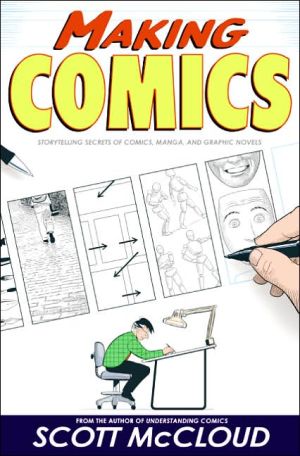Making Comics: Storytelling Secrets of Comics, Manga, and Graphic Novels
Scott McCloud tore down the wall between high and low culture in 1993 with Understanding Comics, a massive comic book about comics, linking the medium to such diverse fields as media theory, movie criticism, and web design. In Reinventing Comics, McCloud took this to the next level, charting twelve different revolutions in how comics are generated, read, and perceived today. Now, in Making Comics, McCloud focuses his analysis on the art form itself, exploring the creation of comics, from the...
Search in google:
Scott McCloud tore down the wall between high and low culture in 1993 with Understanding Comics, a massive comic book about comics, linking the medium to such diverse fields as media theory, movie criticism, and web design. In Reinventing Comics, McCloud took this to the next level, charting twelve different revolutions in how comics are generated, read, and perceived today. Now, in Making Comics, McCloud focuses his analysis on the art form itself, exploring the creation of comics, from the broadest principles to the sharpest details (like how to accentuate a character's facial muscles in order to form the emotion of disgust rather than the emotion of surprise.) And he does all of it in his inimitable voice and through his cartoon stand–in narrator, mixing dry humor and legitimate instruction. McCloud shows his reader how to master the human condition through word and image in a brilliantly minimalistic way. Comic book devotees as well as the most uninitiated will marvel at this journey into a once–underappreciated art form.Publishers WeeklyEvery medium should be lucky enough to have a taxonomist as brilliant as McCloud. The follow-up to his pioneering Understanding Comics (and its flawed sequel Reinventing Comics) isn't really about how to draw comics: it's about how to make drawings become a story and how cartooning choices communicate meaning to readers. ("There are no rules," he says, "and here they are.") McCloud's cartoon analogue, now a little gray at the temples, walks us through a series of dazzlingly clear, witty explanations (in comics form) of character design, storytelling, words and their physical manifestation on the page, body language and other ideas cartoonists have to grapple with, with illustrative examples drawn from the history of the medium. If parts of his chapter on "Tools, Techniques and Technology" don't look like they'll age well, most of the rest of the book will be timelessly useful to aspiring cartoonists. McCloud likes to boil down complicated topics to a few neatly balanced principles; his claim that all facial expressions come from degrees and combinations of six universal basic emotions is weirdly reductive and unnerving, but it's also pretty convincing. And even the little ideas that he tosses off-like classifying cartoonists into four types-will be sparking productive arguments for years to come. (Sept.) Copyright 2006 Reed Business Information.
\ From Barnes & NobleThe Barnes & Noble Review\ Critically acclaimed comic book artist and renowned cartoon theorist Scott McCloud (Understanding Comics and Reinventing Comics) is back with yet another invaluable reference guide for budding cartoonists and comic book fans alike, the aptly titled Making Comics. \ Structuring his book as a comic about the craft of making comics, McCloud explores the storytelling secrets of comics artists; from "Writing with Pictures" (how clarity, persuasion, and intensity can make or break a story line) and "Stories for Humans" (an in-depth examination of character design, facial expressions, and body language) to "Making Comics," which gives a concise history of the comics industry and speculates about cutting-edge trends in the genre, like manga-style comics and webcomics.\ \ This 272-page guide is packed with a mother lode of comics-related insights and information. Aside from the aforementioned chapters, other sections analyze the power of words, tools, and techniques, as well as difficulties associated with world building. Also included is an extensive bibliography and suggested reading list. Making Comics will not only educate -- and encourage -- anyone considering a career in the field, it will captivate any comic book fan from the first page to the last. McCloud concludes with some inspirational words of wisdom: "No matter how many tons of ink we've spilled on it over the years comics itself has always been a blank page for each new hand that approaches." Paul Goat Allen\ \ \ \ \ \ Publishers WeeklyEvery medium should be lucky enough to have a taxonomist as brilliant as McCloud. The follow-up to his pioneering Understanding Comics (and its flawed sequel Reinventing Comics) isn't really about how to draw comics: it's about how to make drawings become a story and how cartooning choices communicate meaning to readers. ("There are no rules," he says, "and here they are.") McCloud's cartoon analogue, now a little gray at the temples, walks us through a series of dazzlingly clear, witty explanations (in comics form) of character design, storytelling, words and their physical manifestation on the page, body language and other ideas cartoonists have to grapple with, with illustrative examples drawn from the history of the medium. If parts of his chapter on "Tools, Techniques and Technology" don't look like they'll age well, most of the rest of the book will be timelessly useful to aspiring cartoonists. McCloud likes to boil down complicated topics to a few neatly balanced principles; his claim that all facial expressions come from degrees and combinations of six universal basic emotions is weirdly reductive and unnerving, but it's also pretty convincing. And even the little ideas that he tosses off-like classifying cartoonists into four types-will be sparking productive arguments for years to come. (Sept.) Copyright 2006 Reed Business Information.\ \ \ Library JournalThe third in McCloud's remarkable series (following the groundbreaking Understanding Comicsand its sequel, Reinventing Comics). Directed at budding comics creators, this volume explores the intricacies of cartooning with McCloud's trademark inventiveness, analytical skill, and humor. Fascinating and inspiring.\ —Steve Raiteri\ \ \ \ \ \ School Library JournalAdult/High School-A follow-up to the author's Understanding Comics (Kitchen Sink, 1993) and Reinventing Comics (DC Comics, 2000), this volume uses the same graphic style and narrator to explain the technical aspects of creating comics. From the layout of each frame and the placement of words and characters to creating facial expressions, symbolism, and more, this highly detailed resource is for serious artists wishing to gain further technical knowledge. Every concept is broken down into its individual elements and thus is probably more than most casual readers would want to know. The book is well organized with a specific table of contents and an annotated bibliography and suggested reading list.-Corinda J. Humphrey, Los Angeles Public Library Copyright 2006 Reed Business Information.\ \








